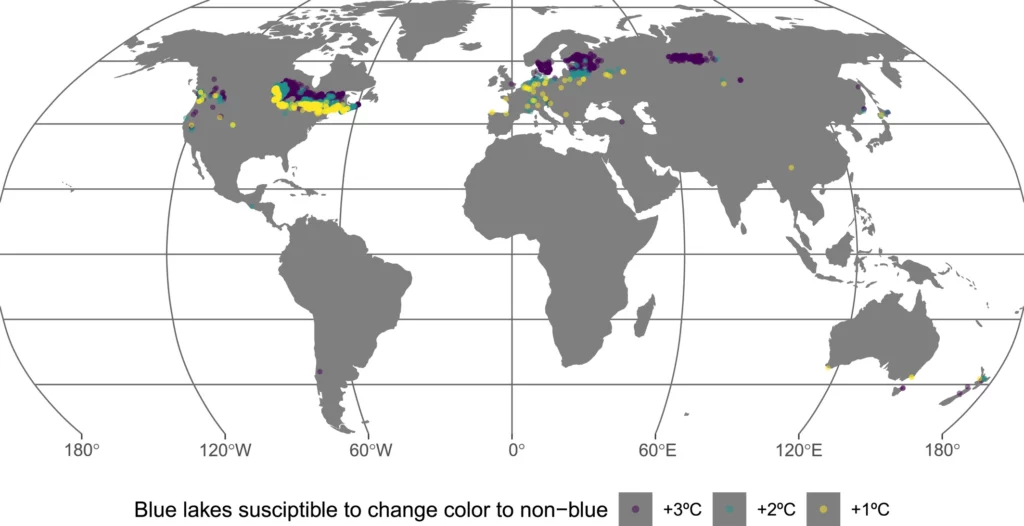
Researchers analyzed satellite photos of more than 85,000 lakes from across the world and uncovered a disturbing trend: warming temperatures are expected to alter the color of many currently blue-tinted lakes. Instead of crystal waters, some lakes may turn green or brown as the warm water promotes algal blooms.
Bye-bye, blue lakes
Water bodies can take on a surprisingly high number of different colors. In New York State alone, for instance, one can find White Lake, Green Lake, Silver Lake, Black Lake, and Lake Clear, each name alluding to the qualities of their water.
Some water lakes owe their deep blue coloring to the absence of algae and other suspended materials, such as sediments and organic matter particles. Because blue wavelengths of light are shorter than red light, it gets scattered to create a deep blue color. The same phenomenon, called Rayleigh scattering, is responsible for blue being the predominant color of the sky.
A deep blue lake is typically a pristine lake, with low human impact in the surrounding watershed. On the flipside, you have green and brown lakes, whose colors can be explained by the high concentration of impurities. Green lakes contain a lot of chlorophyll-containing algae, where chlorophyll is the same green pigment that plants use to make food during photosynthesis. Brown lakes have a lot of tannins, phenolic compounds from, dissolved organic matter, such as leaves and flowers. It’s no coincidence that brown lakes are typically surrounded by forests or wetlands.
But that’s just the general color trends since all lakes will typically change color, at least a bit, throughout the year depending on whether or not it rained recently and washed down sediment or it is the season for algal blooms. Unfortunately, a new study suggests that the number of deep blue lakes is expected to fall dramatically due to climate change.
Researchers led by Xiao Yang, a hydrologist at Southern Methodist University in Dallas, compiled a huge database containing Landsat 8 satellite observations of more than 85,000 lakes performed between 2013 and 2020. For each lake, the researchers assigned a blue, green, or brown color depending on what color showed up most frequently in the seven-year-long observational period. They even made an interactive map, which you can use to zoom in and check the average color of lakes near you.

The average lake color was matched with changes in climate conditions for each region. Lakes where summer temperatures were below 19° Celsius tended to be bluer than lakes that experience warmer summers. About a third of all lakes are ‘blue’, but around 14% of the blue lakes identified by the researchers sit right at the cusp of this threshold, and are expected to easily cross it within the next few decades, or perhaps even sooner. In Britain alone, where summer temperatures are expected to rise by an additional 3°C by the end of the century, 3,800 currently bluish lakes could turn green or brown as the warm waters invite algae.
Besides losing their aesthetic value and tourist appeal, lakes that turn green or brown are more costly to clean up and provide safe drinking water. A change in lake color could also cause a change in the lake’s ecosystem. As such, the researchers conclude that monitoring lake water color is an essential climate variable that is “crucial for understanding the impact of climate and land use change on lakes into the future.”
The findings appeared in the journal Geophysical Research Letters.


